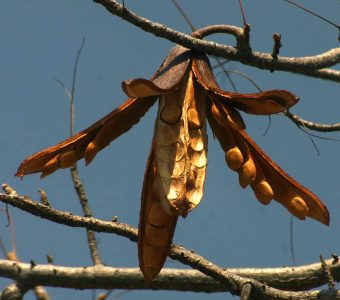
Botanical Name: Entandrophragma caudatum
Common Name: Wooden Banana, Mululu, Mupumena, Mpanje, Mupingili .
Plant Family: Meliaceae (Mahogany Family)
Growth Form, Habitat and Distribution: A tall deciduous tree with a distinctive, straight trunk up to 2m in diameter, sometimes buttressed, untidily branching with a rounded crown. Confined to the drier and sandier southern half of Zambia, often in riverside and Munga woodland, in a wide range of habitats. Similar to E. delevoyi which is mainly a northern species, has less tapering leaflets and the capsule splits from the base.
Size: Height up to 30m, spread 8 to 15m.
Bark: Greyish, rough with plate-like scales (up to 12cm), peeling to show a pale under bark.
Leaves: Compound, paripinnate with 5 to 8 pairs of ovate to lanceolate, drooping leaflets (up to 11cm), dark green above, paler below, apex sharp into a thin point, clustered at branch-ends. Petiole up to 4cm. Leafless for at least 4 month from May
Flowers: Inconspicuous in loose terminal sprays up to 20cm, white to yellowish-green, August to October.
Fruit: A long light brown, woody capsule (up to 15cm), slitting into 5 vales curling back (hence the wooden banana name), releasing about 40 winged seeds, July to September.
Uses: The Litunga’s canoe in Western Province is from this tree. The timber is in commercial demand but supply limited and the species is threatened.
